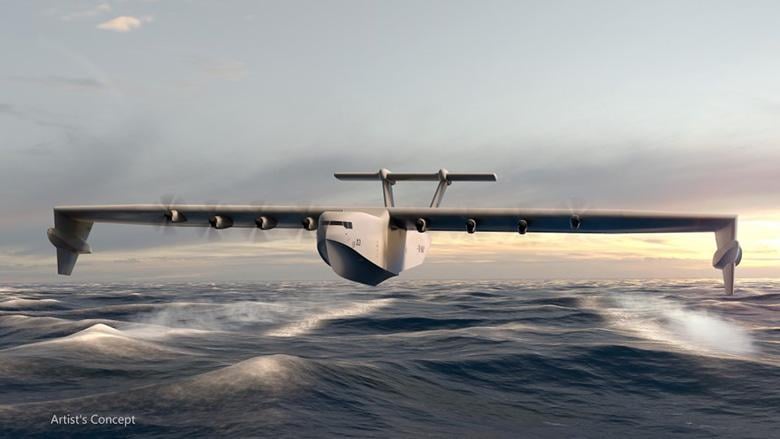
Aurora Flight Sciences' design concept for DARPA's Liberty Lifter program
One of the U.S. defense department's efforts to develop a capability to deploy large quantities of personnel and materiel to coastal regions by air took a small step forward last week, while another program pursuing a similar outcome appears to have stalled.
A contract modification worth $8.3m was awarded May 9 to Aurora Flight Sciences to extend the Boeing subsidiary's work on Phase 1b of the Defense Advanced Research Projects Agency's (DARPA) Liberty Lifter seaplane program. As that project advances towards preliminary design review stage, currently scheduled for early 2025, U.S. Special Operations Command's (SOCOM) program executive officer for fixed-wing aviation programs confirmed that the command had paused its three-year-old effort to give a water take-off and landing capability to the Lockheed MC-130J.
The MC-130J Amphibious Concept (MAC) program has been examining the technical feasibility and economic viability of attaching large floats to retired Commando Solo aircraft. Test flights were planned for 2022, then pushed further back, due to what the then SOCOM PEO for fixed-wing, Col. Ken Kuebler, aid was a significant technological challenge. "We might not be breaking physics [but] this is hard engineering," he told AWST in 2023.
Some of these challenges will also have to be addressed by the two Liberty Lifter competitors, though that project is taking a different approach to achieving a superficially similar capability. The proposed aircraft is expected to operate mostly close to the surface of the water as a wing-in-ground-effect platform, but will be capable of flight up to 10,000ft. The two consortia are taking significantly different approaches, allowing for the program to explore "a relatively large design space" during its first phase, DARPA's program manager, Dr. Christopher Kent, said when the project was launched.
Aurora leads a consortium which includes Oregon-based shipyard ReconCraft, and Leidos-owned marine engineering firm Gibbs & Cox. Their proposal resembles traditional flying-boat designs, with a rear cargo door, eight turboprops mounted on a high wing, and floats attached to the wingtips. The rival consortium, led by General Atomics Aeronautical Systems and also involving Baltimore-based naval technology firm Maritime Applied Physics Corp., envisions a twin-hulled aircraft with a mid wing and 12 turboshaft engines.
Explaining the MAC pause during a May 7 presentation to the SOF Week conference, Kuebler's successor, Col. T. Justin Bronder, suggested that, while the capability was still one the command desired, the program was not presently cost-effective. As AWST noted when the program was announced in 2021, the C-130 is capable of airdropping troops and supplies in its conventional configuration, so using the platform for a littoral resupply mission would not necessarily require this degree of modification. However, being able to land on water would allow for significant range extension on oceanic missions, provided fuel could be pre-positioned appropriately.
On its Liberty Lifter program web page, DARPA says the objective of the project is to create a logistics, search-and-rescue and disaster-response platform that combines "the scale of ships with the speed of air transport". The program is working towards an aircraft comparable in size to a C-17, which has four times the payload capacity of a C-130J. A key component of the project is that the aircraft be "affordable". At launch, the agency said it "anticipates teaming with one or more DoD Service and international partners" on the program's second phase, which will see the manufacture of a full-scale demonstrator.
